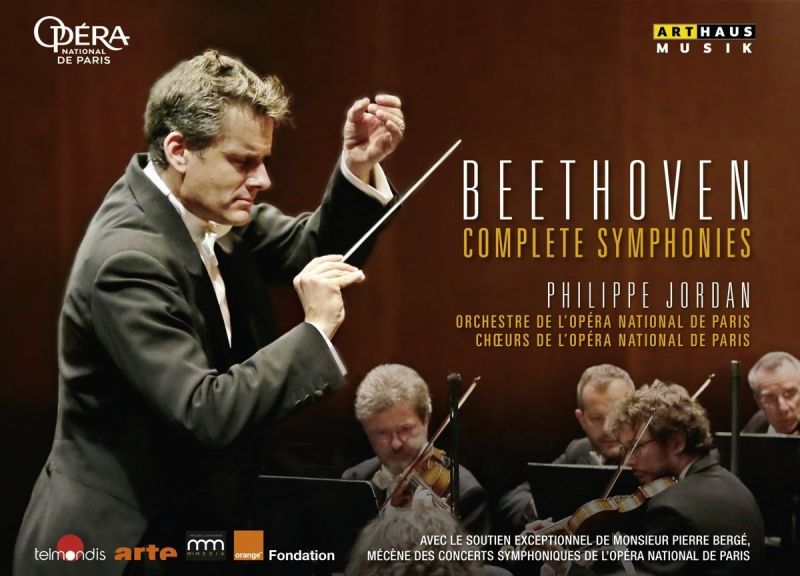BEETHOVEN Complete Symphonies
View record and artist detailsRecord and Artist Details
Composer or Director: Ludwig van Beethoven
Genre:
Orchestral
Label: Arthaus Musik
Magazine Review Date: 12/2016
Media Format: Digital Versatile Disc
Media Runtime: 405
Mastering:
DDD
Catalogue Number: 109 248

Tracks:
| Composition | Artist Credit |
|---|---|
| Symphony No. 1 |
Ludwig van Beethoven, Composer
Ludwig van Beethoven, Composer Paris National Opera Orchestra Philippe Jordan, Conductor |
| Symphony No. 2 |
Ludwig van Beethoven, Composer
Ludwig van Beethoven, Composer Paris National Opera Orchestra Philippe Jordan, Conductor |
| Symphony No. 3, 'Eroica' |
Ludwig van Beethoven, Composer
Ludwig van Beethoven, Composer Paris National Opera Orchestra Philippe Jordan, Conductor |
| Symphony No. 4 |
Ludwig van Beethoven, Composer
Ludwig van Beethoven, Composer Paris National Opera Orchestra Philippe Jordan, Conductor |
| Symphony No. 5 |
Ludwig van Beethoven, Composer
Ludwig van Beethoven, Composer Paris National Opera Orchestra Philippe Jordan, Conductor |
| Symphony No. 6, 'Pastoral' |
Ludwig van Beethoven, Composer
Ludwig van Beethoven, Composer Paris National Opera Orchestra Philippe Jordan, Conductor |
| Symphony No. 7 |
Ludwig van Beethoven, Composer
Ludwig van Beethoven, Composer Paris National Opera Orchestra Philippe Jordan, Conductor |
| Symphony No. 8 |
Ludwig van Beethoven, Composer
Ludwig van Beethoven, Composer Paris National Opera Orchestra Philippe Jordan, Conductor |
| Symphony No. 9, 'Choral' |
Ludwig van Beethoven, Composer
Daniela Sindram, Mezzo soprano Günther Groissböck, Bass Ludwig van Beethoven, Composer Paris National Opera Chorus Paris National Opera Orchestra Philippe Jordan, Conductor Ricarda Merbeth, Soprano Robert Dean Smith, Tenor |
Author: Richard Osborne
It is a forward-thinking director of the Paris Opéra who invites his orchestra to perform the nine Beethoven symphonies. Like the Covent Garden and New York Metropolitan orchestras (‘Levine’s Ferrari’ as Jordan calls the latter), the orchestra of the Paris Opéra has never doubled as a concert-giving organisation. France’s (and the world’s) first great Beethoven conductor, François-Antoine Habeneck, might have established such an ensemble in the late 1820s; yet, despite being director of the much-lauded Opéra orchestra, he lacked the necessary political and financial power. As a working alternative, he established the Orchestre de la Société des Concerts du Conservatoire, with which he spent many years rehearsing and preparing these formidably difficult works for public performance.
In his preface to the set, Jordan talks of small halls (the tiny Lobkowitz Palace where the Eroica was first performed), slimmed-down orchestras and fast metronomes. In the event, none of this pertains. The vast modernist Opéra Bastille and the smaller and more generously upholstered Palais Garnier both boast large auditoria. As a consequence, the orchestra is substantial (roughly the size of Habenek’s, though without Habeneck’s antiphonally divided violins), with speeds that are keen without being unduly rushed.
As a conductor, Jordan knows his trade. Those who remember Hans Schmidt-Isserstedt’s widely collected 1960s Decca cycle with the Vienna Philharmonic will find similar satisfaction here, even if, understandably, there are times when the Paris musicians take fire and times when their approach to the notes is rather more circumspect. The only performance I didn’t care for was the that of the Ninth; it has a tentative first movement and a finale where the large and slightly unruly Paris Opéra Chorus brings to the music something of the feel of a works outing.
Jordan’s reading of the Eroica may be work in progress (there are some old-fashioned slowings and subito piano ‘effects’ which could usefully be discarded) but the road map is a good one. In the Seventh and Eighth symphonies he refuses to be rushed yet retains a keen sense of where tension needs to be built. He segues the opening two movements of the Seventh Symphony and the second and third movements of the Eighth to rather good effect.
There are spruce and stylish accounts of the two early symphonies but it is the performances of the Fourth and Fifth symphonies that genuinely stand out. The Fifth has always been a French speciality. Carl Schuricht’s 1949 Paris Conservatoire recording (Decca, 9/50) was famous in its day. Indeed, the encomium it received in these columns (‘intense, vital and dramatic’) could be used here more or less word for word. Like Schuricht, Jordan keeps the Scherzo and the finale in the same basic pulse. One difference is that Jordan takes all the repeats, including the rarely played Scherzo repeat. In the Fourth Symphony, German heft is married to Grecian fire rather as it is in Karajan’s first Berlin account (DG, 2/63), complete with the same lovingly unfurled string and wind appoggiaturas in the first-movement development.
The video direction is sensible. Look up from the score and the camera will generally be following what you are following. Sadly the sound quality is none too good from either venue. A certain boxiness prevails, added to which there are some acoustic black spots which have either gone unnoticed or been impossible to remedy. Most troubling are the pianissimo horn pedals which go off like foghorns, drowning out the real matter in hand. The start of the Ninth Symphony suffers particular badly, as does the ‘Scene by the Brook’ in what is an otherwise splendidly earthy account of the Pastoral Symphony. We are used to hearing nightingales, cuckoos and quails in the Heiligenstadt woods near where Beethoven walked but not the bittern’s unearthly boom.
Discover the world's largest classical music catalogue with Presto Music.

Gramophone Digital Club
- Digital Edition
- Digital Archive
- Reviews Database
- Full website access
From £8.75 / month
Subscribe
Gramophone Full Club
- Print Edition
- Digital Edition
- Digital Archive
- Reviews Database
- Full website access
From £11.00 / month
Subscribe
If you are a library, university or other organisation that would be interested in an institutional subscription to Gramophone please click here for further information.




